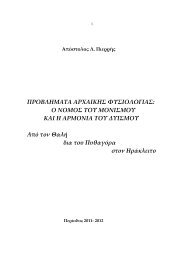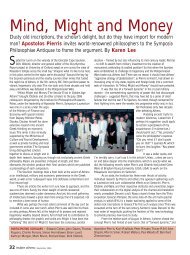APPENDIX C΄ ON DEPILATION: BODY COSMETICS IN CLASSICAL ...
APPENDIX C΄ ON DEPILATION: BODY COSMETICS IN CLASSICAL ...
APPENDIX C΄ ON DEPILATION: BODY COSMETICS IN CLASSICAL ...
You also want an ePaper? Increase the reach of your titles
YUMPU automatically turns print PDFs into web optimized ePapers that Google loves.
588 <strong>APPENDIX</strong> <strong>C΄</strong><br />
B·ÏËÙ›·˜ Ùɘ B·Ï‹ÙÔ˘. Ôî ÔåÎÔÜÓÙ˜ BÚ¤ÙÙÈÔÈ, ηd ì ¯ÒÚ· BÚÂÙ-<br />
Ù›·, ηd ì ÁÏáÛÛ·. \AÚÈÛÙÔÊ¿Ó˘ (Fr. 719 Di; 886 Blaydes; Fr. 638<br />
PCGr. vol. III 2 p. 335) «Ì¤Ï·ÈÓ· ‰ÂÈÓc ÁÏáÙÙ· BÚÂÙÙ›· apple·ÚÉÓ».<br />
\AÓÙ›Ô¯Ô˜ ‰b ÙcÓ \IÙ·Ï›·Ó appleÚáÙfiÓ ÊËÛÈ ÎÏËıÉÓ·È BÚÂÙÙ›·Ó, ÂrÙ·<br />
OåÓˆÙÚ›·Ó. For the two occurrences of ÁÏáÛÛ·, Bochartus (followed<br />
by Meineke) read apple›ÛÛ· very appositely at first sight. The Etym.<br />
Magnum (p. 213, 8) s.v. BÚÂÙÙ›· has: ̤ϷÈÓ· apple›ÛÛ·. ηd ‚¿Ú‚·ÚÔ˜Ø<br />
àapplee ÙÔÜ BÚÂÙÙ›ˆÓ öıÓÔ˘˜ (or «BÚ¤ÙÙÈÔ˜» âıÓÈÎÔÜ). And the same in<br />
effect occurs in Hesychius s.v. BÚÂÙÙ›·Ø ̤ϷÈÓ· (an addendum<br />
? j ‚¿Ú‚·ÚÔ˜). àapplee ÙÔÜ BÚÂÙÙ›ˆÓ öıÓÔ˘˜. The<br />
lexicographers note rather support the ÁÏáÙÙ· in Aristophanes’<br />
fragment: ‚¿Ú‚·ÚÔ˜ ÁÏáÛÛ·. If Aristophanes wrote ÁÏáÙÙ·, we can<br />
be sure, he was playing one of his usual, ingenious games of double<br />
entendre. In any case the ̤ϷÈÓ·, ‰ÂÈÓc BÚÂÙÙ›· would have made<br />
clear the allusion to the famous pitch.<br />
I shall end this study on ancient male depilation by referring to<br />
chapter III, book III of Clement, Paedagogus, entitled: appleÚe˜ ÙÔf˜<br />
ηÏψappleÈ˙Ô̤ÓÔ˘˜ ÙáÓ àÓ‰ÚáÓ. V. especially 15, 2-4; 17, 3; 19, 1 21,<br />
1; 23, 2; 5. We have in these passages a true picture of the situation,<br />
exaggerated only in the intensity of its absolute condemnation.<br />
I shall conclude this essay by adding some further remarks on<br />
depilation.<br />
(1) We are informed of a theatrical business very similar to Baubo’s<br />
action as Arnobius represents it (for Clement’s account, and what I<br />
take to have been the Orphic account lying at the source of both, see<br />
the discussion in this work). In Aristophanes, Lysistrata, 88-9, K·ÏÔ-<br />
Ó›ÎË the Athenian adds to the praise addressed to a Boeotian prime<br />
young lady, by saying: ηd Óc ¢›· / ÎÔÌ„fiٷٷ ÙcÓ ‚ÏË¯Ò Á apple·Ú·-<br />
ÙÂÙÈÏ̤ÓË. BÏË¯Ò refers here to the Á˘Ó·ÈÎÂÖÔÓ ·å‰ÔÖÔÓ, as the<br />
scholiast explains. But he adds ad ÎÔÌ„fiٷٷ: ÎÔ̄ᘠö¯Ô˘Û· Ùe<br />
·å‰ÔÖÔÓØ êappleÙÔ̤ÓË ‰b ·éÙÔÜ ÙÔÜÙfi ÊËÛÈ. So we have the placing of a<br />
hand to, and caressing gently that venerable part of the female nature<br />
but it is of course here another one’s examining hand, unlike Baubo’s<br />
case.<br />
(2) It is interesting to note a passage which could provide another<br />
point of similarity with Arnobius account of Baubo’s action. In<br />
Aristophanes, Ecclesiazousai 719 sqq., Praxagora wants to stop










